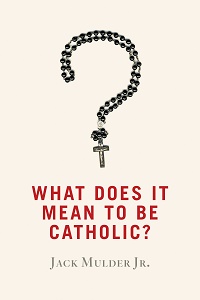What does it mean to be Catholic? The question is simple but the answer is fraught with complexities.
 Author of the book Jack Mulder.
Author of the book Jack Mulder.
Jack Mulder Jr., What Does it Mean to be Catholic? (Grand Rapids, MI: W.B. Eerdmans, 2015) 226 pp.
What does it mean to be Catholic? The question is simple but the answer is fraught with complexities. Is there a recognizable core, a pervasive blueprint, a distinct pattern of what Roman Catholicism is all about? The issue is worth tackling, especially in times like ours where confessional identities are often blurred and flattened.
The merit of this book is to present a comprehensive, albeit short and readable, introduction to what is constitutive of the Roman Catholic identity. The intention of the Author, an associate professor of philosophy at Hope College (Michigan, USA), is to show “a small glimpse of the internal coherence, the beauty, and the depth of the Catholic faith” (p. 9). Rather than testing Roman Catholicism in terms of biblical truth or gospel faithfulness, the primary interest is to underline the coherent nature of Roman Catholicism in terms of its aesthetical attraction and profound structure of thought.
In itself this is already an indication of what it means to be Catholic: looking for coherence, beauty and depth, not necessarily according to and under God’s revealed Word. The Author was raised in the Protestant faith and converted to Roman Catholicism in his adulthood. So he knows the evangelical subculture quite well. In presenting his newly found faith he often and interestingly interacts with concerns and questions that are normally asked by evangelical protestants.
Catholic Distinctiveness
The opening sentence of chapter 1 well captures the essence of what Roman Catholicism is all about in its practical outworking. “In my wallet I carry a little card with a picture of St. Thomas Aquinas (1225-1274) and a tiny piece of cloth laminated to it. Next to the cloth it reads: This piece of cloth has been touched by his relics” (p. 11). What used to be thought of as being the quintessence of idolatry, i.e. the reliance on pictures, relics and saints, is now seen as expressing the genuine longing of the Catholic faith: the blessed presence of divine grace accessed through tangible objects and human holy mediators.
 Cover of the book.
Cover of the book. The Author readily acknowledges that in order to make sense of this practice one needs to have a wider concept of Divine Revelation than Scripture alone. According to Roman Catholicism, Scripture and tradition are streams of the same wellspring of Revelation that the Church is given the task to rightly interpret and duly apply, thus governing the “development” of doctrine and practice. From the religious point of view, carrying the card with St. Thomas Aquinas makes sense given the fact that the “formal principle” of the Roman faith is not Scripture alone, but Scripture as interpreted as part of a bigger Tradition ultimately received and spelt out by the teaching office of the Church. As it was the case in the XVI century, the evangelical “Scripture alone” is utterly incompatible with Roman Catholicism.
Having clarified this foundational epistemological point, the rest of the book aptly presents the Roman Catholic faith, introducing topics as central and diverse as The Church and her Magisterium, God and Humanity, The Person and Work of Christ, Mary and the Communion of the Saints, The Seven Sacraments, Heaven, Hell and Purgatory, The Human Person. All in all, the Author well manages to navigate the complexities of Catholic doctrine and practice, always trying to trace their doctrinal development and pointing to the coherence of the whole in terms of the present-day teaching of Roman Catholicism. He does a great job in expounding the coherence of the system given its wide foundations which go well beyond the Bible. The problem is: is it what the biblical Gospel is all about? Once established that the normative reference point is not Scripture alone, every point he deals with raises serious concerns from a biblical perspective.
A Gradualist View of Salvation
A test-case of the deviant direction of Roman Catholicism has to do with the view of salvation as having a universal scope and a hopeful end for all. The Author sides with the post-Vatican II account whereby there are circles of salvation which ultimately embrace the whole of humanity. Quoting Paul VI and John Paul II, but evoking standard Vatican II teaching, “There are four concentric circles of people: first, all humanity; second, the worshipers of the one God; third, all Christians; and fourth, Catholics themselves” (p. 9). Salvation is seen as a gift that people receive in different degrees depending on the circle they chose to identify with or find themselves in.
Roman Catholics receive God’s grace in the fullest measure through the sacraments administered by the (Roman) Church under the Pope and the bishops who are the successors of the apostles; other Christians receive God’s grace to a lesser extent because they retain true elements of the faith but lack the fullness of it in not being in full fellowship with the Church of Rome. Religious people receive it because they have a sense of the divine, although they miss important aspects of the faith. Finally, the whole of humanity receives it because they are human and therefore existentially open to God’s grace which works in mysterious ways. Ultimately, “the only real way to get outside of God’s grace is to expel oneself from it” (p. 190). The conditions for such self-expulsion are so remote and limited that practically there is hope that all will be saved. This is quite different from clear biblical teaching that turns the picture upside down.
According to Scripture we are all by nature children of wrath (Ephesians 2:3), all sinners (Romans 3:23), all under his judgment (John 3:18). It is not us who exclude ourselves from God’s grace. Because of sin we are all born into this condition. Roman Catholicism turns the argument around and believes the contrary, i.e. we are all born into God’s grace albeit at various levels of depth and at different degrees.
As an aside comment, the Author interestingly says that “when evangelical leader Rob Bell came out with a book called Love Wins, which only raises the possibility of everyone ending up in heaven, and never definitively claims that this will happen, controversy erupted in evangelical circles, but Catholics took very little notice” (p. 187). This is no surprise given the hopeful scope of the Roman Catholic gradualist view of salvation for all.
The book is very honest in presenting the Roman Catholic faith and not hiding points of controversy with other Christian traditions. Contrary to some attempts to blur the lines, this volume does a good job in highlighting what is distinctive of Roman Catholicism and therefore in showing how it is different from the evangelical faith. Even in its post-Vatican II outlook, Roman Catholicism is still idiosyncratic to Scripture alone, Christ alone and faith alone.
Leonardo de Chirico is pastor, Vatican expert and vice-President of the Italian Evangelical Alliance (AEI).

Las opiniones vertidas por nuestros colaboradores se realizan a nivel personal, pudiendo coincidir o no con la postura de la dirección de Protestante Digital.
Si quieres comentar o